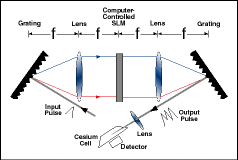Phased out by Coherent Control
Lawrence NormieA "textbook" laboratory demonstration of a basic quantum physical principle could lay the groundwork for practical applications in photochemistry, forensics, quantitative analysis and quantum computing. Using ultrafast optical techniques, researchers at the Weizmann Institute of Science have shown a new way of controlling light absorption in atoms.
 Shown here is an experimental layout for coherent quantum control of two-photon transitions in atomic cesium. A computer-controlled liquid crystal spatial light modulator, used in a pulse shaper, allows dynamic pulse shaping. The shaped output pulses are focused into the cesium cell, and the detector collects the two-photon fluorescence.
Shown here is an experimental layout for coherent quantum control of two-photon transitions in atomic cesium. A computer-controlled liquid crystal spatial light modulator, used in a pulse shaper, allows dynamic pulse shaping. The shaped output pulses are focused into the cesium cell, and the detector collects the two-photon fluorescence.
A seminal experiment -- performed recently by Doron Meshulach and Yaron Silberberg in the institute's Ultrafast Optics Group -- demonstrates the multiphoton coherent quantum control effect, in which the ability of atoms to absorb energy at their resonant frequency can be controlled by altering the shape of the exciting light source. To do this, the Weizmann group built a computer-controlled pulse-shaping system to selectively modify the phase distribution of the frequency components of the ultrashort-pulse laser source (a mode-locked Ti:sapphire laser) to excite two-photon electronic transitions in cesium atoms.
By carefully tinkering with the phase distribution, the researchers were able to control the rate at which light was absorbed by the atoms. In particular, they created so-called "dark" pulses. The phase distribution of the shaped pulse elicited no absorption whatsoever, so fluorescent emission -- indicating electronic transitions -- was effectively switched off even though the original energy and power spectrum of the pulse was preserved. Because of the interference between possible quantum trajectories through virtual transition levels, it is also possible to spread out the pulse so that its peak energy is very low, while preserving the same excitation level as an intense shorter pulse.
The pulse shaper essentially consists of two grating spectrometers on either side of a programmable liquid crystal array modulator, which acts as an adaptive phase filter. The first spectrometer splits the input light source into its spectral components. After the computer-controlled modulator modifies the relative phases of the individual frequency elements, the second spectrometer reassembles them into the original pulse, which now possesses a modified phase and amplitude distribution.
Quantum coherent control relies on the fact that a final state of a quantum interaction can occur through different paths. In particular, the transition rate can be modified depending on the relative phases of the interfering transition amplitudes corresponding to the alternative paths. The Weizmann team exploited the fact that these phases can be controlled through the coherence properties of an external exciting light source, thus facilitating the switching on and off of the atomic energy transitions.
LATEST NEWS
- AmeriCOM Adds President and CEO: People in the News: 5/1/24 May 1, 2024
- Machine Learning Pushes High-Power Lasing Limits May 1, 2024
- IPG Names Industry Veteran Mark Gitin CEO Apr 30, 2024
- 16th Biannual Optatec Conference Continues in Frankfurt Apr 30, 2024
- Celestial Surface Mapping Tech Combines Established Techniques Apr 30, 2024
- TSMC Partnerships Target Integrated Photonics Capabilities Apr 30, 2024
- CLEO Heads to the East Coast Apr 29, 2024
- Qubits Could be Stored in Flash-Like Memory Apr 29, 2024
